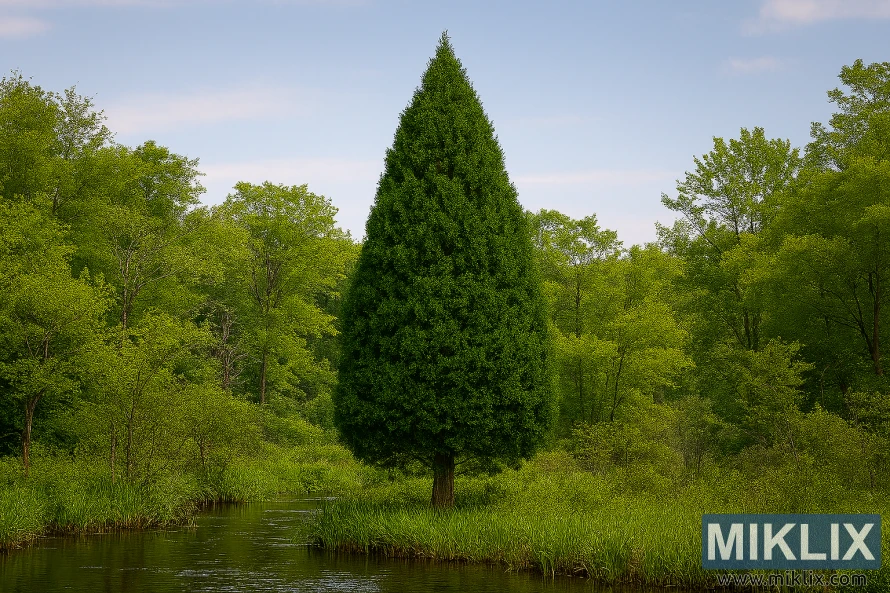Image: American Arborvitae in Native Wetland Landscape
Published: November 3, 2025 at 9:47:24 PM UTC
Explore a high-resolution image of American Arborvitae growing in its natural wetland habitat, showcasing its pyramidal form and ecological setting
This high-resolution landscape image captures a mature American Arborvitae (Thuja occidentalis) thriving in its native wetland habitat, offering a vivid and ecologically accurate portrayal of the species in its natural range. The composition is immersive and botanically rich, ideal for educational, conservation, or cataloging purposes.
The central focal point is a tall, conical American Arborvitae, positioned slightly off-center to the right. Its dense foliage is composed of tightly packed, overlapping scale-like leaves that form vertical sprays from base to crown. The color is a deep, natural green, with subtle highlights where sunlight filters through the canopy. The tree’s silhouette is broad at the base and tapers to a sharp apex, reflecting its characteristic pyramidal form. The trunk is partially visible at the base, with rugged, fibrous bark in muted brown and gray tones.
Surrounding the Arborvitae is a lush wetland ecosystem typical of northeastern North America. In the foreground, a gently meandering stream flows from the left side of the image toward the right, its calm surface reflecting the surrounding vegetation and sky. The stream is bordered by tall grasses, sedges, and aquatic plants, with tufts of greenery extending into the water. The edge of the stream is irregular and natural, with patches of moss and low-growing shrubs adding texture and realism.
The midground and background feature a diverse mix of deciduous trees and native shrubs. Their foliage ranges from bright spring green to deeper summer tones, with varied leaf shapes and canopy structures. Some trees are closer to the viewer, with slender trunks and open branching, while others recede into the distance, forming a layered backdrop. The understory is populated with ferns, saplings, and herbaceous plants, contributing to the biodiversity and ecological authenticity of the scene.
Above, the sky is a soft blue with scattered wispy clouds. Sunlight filters through the canopy, casting dappled shadows on the forest floor and illuminating the Arborvitae’s foliage with a gentle, diffuse glow. The lighting is natural and balanced, enhancing the textures of bark, leaf, and water without harsh contrast.
The composition is well-balanced, with the Arborvitae anchoring the scene and the stream leading the viewer’s eye through the landscape. The image evokes the quiet resilience of this species in its native environment—often found in limestone-rich woodlands, bogs, and northern swamps. Its ecological role as habitat, windbreak, and soil stabilizer is subtly implied through its integration with surrounding flora.
This visual serves as a compelling reference for botanists, ecologists, educators, and landscape designers seeking to understand or showcase the American Arborvitae in its natural context. It highlights the species’ adaptability, structural beauty, and importance within native ecosystems.
The image is related to: A Guide to the Best Arborvitae Varieties to Plant in Your Garden

